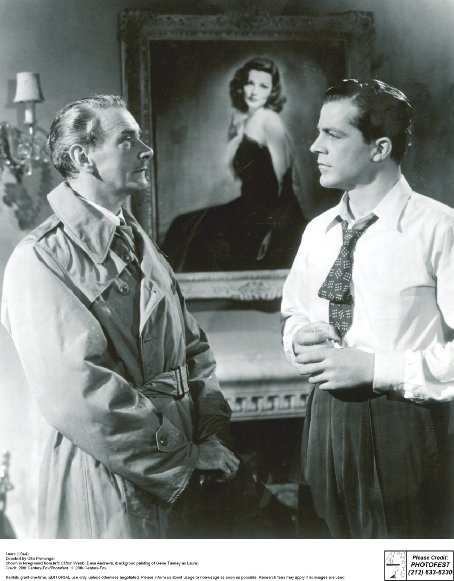
I welcome any excuse to dust off my film textbooks from college, today’s being Laura. The film, (1944), has a reputation as a film noir with a few twists and style points that take it away from being a full display of the genre.
Based on a novel turned play from Vera Caspary, who reportedly wasn’t happy with the film adaptation by Otto Preminger and writers Jay Dratler, Elizabeth Reinhardt and Samuel Hoffenstein, Laura is on the surface a story about a mysterious murder with the themes of love, loneliness and jealously in the background.
Laura (Gene Tierney), well established in her career at an advertising firm and social life, is a sought after woman by Shelby Carpenter (Vincent Price), Waldo Lydecker (Clifton Webb), her mentor of sorts, and Lt. Mark McPherson (Dana Andrews) after she goes out of town for a weekend and is supposedly murdered upon return to her apartment.
Lydecker, a well known, self absorbed columnist and radio show host, is enamored with Laura not long after she sees him at lunch and asks him to endorse a pen advertised by her company.
Many of the men in Laura’s life are enamored by her presence. McPherson, having never met Laura, feels the same way as he works on her murder case and spends most of his time her apartment with her portrait on the wall in nearly every scene there.
Laura won an Oscar for best cinematography after its release, an award that probably carried more meaning in that era, as the film effectively uses light and shadows and fade-in and outs to move the story along.
Some of those styles are characteristic of film noir, but in Laura, for example, the shadows are more often cast of individual characters on a wall or street rather than onto each other.
Laura as a character, while the central focus of the film, is also there to show the inner workings of the other characters and their true personas, motives and desires.
Thus the use of individual shadows stresses paying attention to each character alone rather than their relationships with each other. In one scene, however, as McPherson interrogates Laura at the police station, his shadow is cast on her face — showing they do perhaps have more of a connection than meets the eye.
That is one of the few scenes where I noticed a change in the use of shadows, and I found it to be one of the most telling moments in the film.
Overall, I think love is also one of the most prominent themes in Laura through the very end. Characters, whether it be between Carpenter, Lydecker or McPherson and Laura are often asking each other if they love her or if they think she loves them.
Laura mostly switches from the point of view of Lydecker and McPherson and in the end Lydecker, speaking on a radio broadcast, says it best to exemplify the meaning of love in the film.
“And thus, as history has proved, love is eternal. It has been the strongest motivation for human actions throughout centuries. Love is stronger than light. It reaches beyond the dark shadow of death.”
— Waldo Lydecker